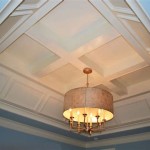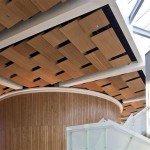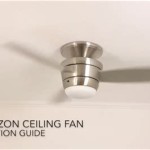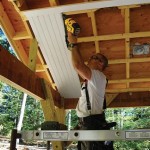Installing a Double Curtain Rod with Ceiling Mount: A Comprehensive Guide
Ceiling-mounted double curtain rods offer a stylish and functional window treatment option, particularly advantageous in situations where wall space is limited or when maximizing window height is desired. This mounting technique allows curtains to hang gracefully from the ceiling, creating a sense of spaciousness and drawing the eye upwards. Installing a double curtain rod involves careful planning, precise measurements, and a thorough understanding of the required tools and techniques. This article provides a comprehensive guide to successfully installing a double curtain rod using a ceiling mount.
Key Considerations Before Installation
Before commencing the installation, several crucial factors must be taken into account to ensure a successful and aesthetically pleasing outcome. These include assessing the ceiling structure, selecting appropriate hardware, and accurately measuring the desired curtain rod placement.
Ceiling Structure Evaluation: The first and most critical step is evaluating the ceiling's structural integrity. Determine the type of ceiling material – drywall, plaster, or concrete. Drywall and plaster require different types of anchors compared to concrete. Locate the ceiling joists or studs. These structural members provide the necessary support for the curtain rod and prevent the anchors from pulling out of the ceiling. A stud finder is an essential tool for this purpose. If joists are not readily accessible or where desired, using appropriate toggle bolts or molly bolts designed for hollow ceilings is paramount. The weight of the curtains and rods must be considered when selecting anchors; heavier curtains will necessitate stronger anchors.
Hardware Selection: Choosing the appropriate hardware is essential for both functionality and aesthetics. Double curtain rods are typically composed of two separate rods – one for sheer curtains and one for heavier draperies. Select rods that complement the room's décor and are of sufficient diameter to support the weight of the curtains. The brackets should be specifically designed for ceiling mounting and compatible with the chosen rods. Ensure that the brackets provide ample space between the rods to allow for easy curtain movement without obstruction. Opt for high-quality screws and anchors that are appropriate for the ceiling material, prioritizing durability and load-bearing capacity.
Accurate Measurement and Placement: Precise measurements are paramount to achieving a visually balanced and functional window treatment. Determine the desired length of the curtain rod, extending beyond the window frame on either side to maximize light and create the illusion of a wider window. Mark the locations for the brackets, ensuring they are evenly spaced and aligned with the window frame. Use a level to ensure the brackets are perfectly horizontal. Consider the height at which the curtains will hang. Mounting the rods higher above the window can create a more dramatic and spacious effect. Remember to factor in the stack back of the curtains – the amount of space the curtains will occupy when fully open – when determining the bracket placement.
Step-by-Step Installation Process
With the necessary preparations completed, the installation process can proceed. This involves marking bracket locations, drilling pilot holes, securing the brackets, and attaching the curtain rods.
Marking Bracket Locations: Using the previously determined measurements, precisely mark the locations for the ceiling-mount brackets. Employ a pencil or marker to clearly indicate the center point of each bracket. Use a level to confirm that the marks are aligned horizontally, ensuring the curtain rod will hang straight. If installing multiple brackets, use a measuring tape to ensure even spacing between them. Double-check all measurements before proceeding to the next step.
Drilling Pilot Holes: Prior to installing the screws or anchors, drill pilot holes at the marked locations. The size of the pilot hole should be slightly smaller than the diameter of the screws or anchors being used. This helps prevent the ceiling material from cracking or splitting during installation. For drywall or plaster ceilings, use a drill bit designed for those materials. For concrete ceilings, use a masonry drill bit. Ensure that the drill is held perpendicular to the ceiling surface to create a straight and clean hole. If encountering a ceiling joist, select a drill bit designed for wood.
Securing the Brackets: With the pilot holes drilled, the brackets can be securely attached to the ceiling. Align each bracket with the corresponding pilot hole and insert the appropriate screws or anchors. For drywall or plaster ceilings, use toggle bolts or molly bolts to provide secure support in the hollow ceiling. Follow the manufacturer's instructions for installing these types of anchors. For concrete ceilings, use concrete screws or anchors. Tighten the screws or bolts firmly, but avoid over-tightening, which could damage the ceiling material or strip the threads. Double-check that each bracket is securely attached and does not wobble.
Attaching the Curtain Rods: Once the brackets are securely mounted, the curtain rods can be attached. Most double curtain rod sets consist of a smaller diameter rod placed closer to the window for sheers, and a larger diameter rod further from the window for room darkening curtains. Place the curtain rods onto the brackets, ensuring they are properly seated and aligned. Some brackets may have set screws or locking mechanisms to secure the rods in place. Tighten these mechanisms according to the manufacturer's instructions. Verify that the rods are level and that there is sufficient space between them for the curtains to move freely.
Troubleshooting and Best Practices
Despite careful planning and execution, unforeseen issues can arise during the installation process. Being prepared to troubleshoot common problems and adhering to best practices will help ensure a successful outcome.
Addressing Weak Ceiling Material: If the ceiling material is weak or damaged, the anchors may not hold securely. In such cases, consider using larger anchors or reinforcing the ceiling with a piece of wood or metal as a backing. Attach the backing to the ceiling joists and then mount the brackets to the backing, providing a more stable and secure attachment point.
Ensuring Proper Alignment: Maintaining proper alignment of the brackets is crucial for a visually appealing result. If the brackets are not level, the curtain rod will hang crookedly. Use a level to double-check the alignment of each bracket before tightening the screws. If necessary, make adjustments to the bracket placement to ensure they are perfectly horizontal. A laser level can be a helpful tool for achieving precise alignment.
Selecting Appropriate Curtain Weight: The weight of the curtains must be compatible with the load-bearing capacity of the curtain rods and brackets. Overloading the rods can cause them to sag or even break. Choose curtains that are appropriate for the size and strength of the rods. If using heavy curtains, consider adding additional brackets to provide extra support. Distribute the weight evenly across the brackets to prevent excessive stress on any single point.
Concealing Hardware: To create a more polished and professional look, consider concealing the hardware as much as possible. Use decorative finials or end caps to cover the ends of the curtain rods. Choose brackets that are discreet and blend in with the décor. If desired, paint the brackets to match the ceiling color, making them less noticeable. Properly installed and concealed hardware can enhance the overall aesthetic appeal of the window treatment.
When dealing with very high ceilings, consider using an extension pole for the drill and screwdriver to maintain stability and control. Prioritizing safety measures such as wearing safety glasses and gloves throughout the installation is crucial. Moreover, maintaining a clean workspace by promptly clearing debris will prevent potential hazards during the process and contribute to a more efficient and organised installation.
By following these guidelines and taking the time to plan and execute the installation carefully, you can successfully install a double curtain rod with a ceiling mount, enhancing the beauty and functionality of your windows and space.

Double Ceiling Bracket For Curtain Rod Fits 1 Inch Front And 3 4 Urbanest

Urbanest Double Ceiling Bracket For Curtain Rod Fits 3 4 Inch Front R

How To Install Ceiling Mount Curtains

How To Install Curtain Rods Best Practices The Shade

How To Install Curtain Rods Best Practices The Shade

How I Install Perfectly Even Curtain Rods Every Time Without A Level T Moore Home Interior Design Studio

Guard Double Curtain Rod Brackets Ceiling Mount Ubuy

Hanging Curtains From The Ceiling Home Depot

How To Hang Curtains From The Ceiling Home Depot
How To Measure For Double Designer Curtains
Related Posts








